Colsac | Colsac II | Colsac III | Vehicle/trip counts
The Merrimac Ferry, which crosses the Wisconsin River between Sauk and Columbia counties, is Wisconsin's only free ferry. It shuttles WIS 113 traffic between Okee, on the east bank, and Merrimac on the west.
Ferry service has been provided in this area for more than a century. In 1844, four years before Wisconsin became a state, Chester Mattson, the second settler on the site of the village of Merrimac, obtained charters to provide ferry service at this location. The ferry was operated long before the development of a regular roadway.
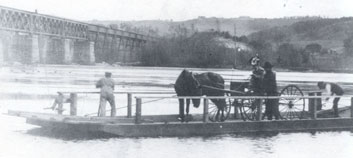
Old Merrimac ferry - carrying horse, a buggy and a few passengers.
Mattson charged either 0.35 cents or $1 to ferry a team and wagon across the river, depending upon who you're talking to. But, whatever the fare, the ferryman earned it for his muscles provided a good share of the ferry's power until a gasoline engine was added around the turn of the century. Another private investor, W.P. Flanders, took over the service in 1849 for the sum of $700, and for many years it continued as a private operation.
Colsac
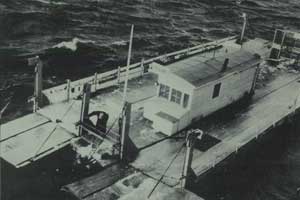
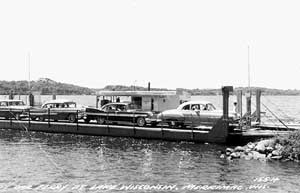
Photo courtesy of the town of Merrimac website.
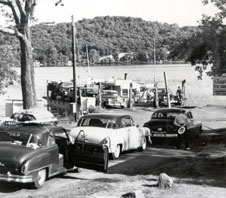
Cars waiting in line to board the Merrimac Ferry, Colsac.
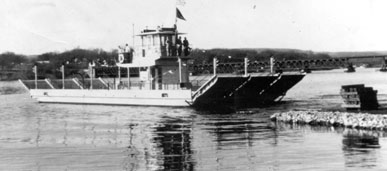
Merrimac Ferry, Colsac II.
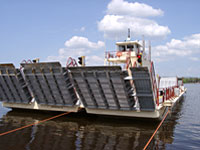
Merrimac Ferry, Colsac III.
The original "Colsac" (a phonetic combination of the two names, Columbia and Sauk counties) was built in 1924 in Dubuque, Iowa. It was operated as a toll ferry by these counties until 1933, when it was acquired by the old State Highway Commission. It has operated as a free ferry since Columbia and Sauk counties turned it over to the state without charge.
Various methods have been used over the years to propel the vessel. Area residents recall stories of a "scow being pulled across the river by horses harnessed to a long cable," but later it was current propelled. A cable was stretched across the river on which the ferry rode and ropes were adjusted at the proper angle to take advantage of the current. In later years, a small gasoline-propelled boat was installed. The first Colsac was also propelled by a gasoline engine.
The village of Merrimac purchased the old ferry boat, Colsac, for $300 to be used for historical purposes. It resided in the village park for many years and was finally "recycled."
Colsac II
Colsac II, built by Marinette Marine Corporation in Marinette, Wisconsin, cost approximately $77,000 and was capable of carrying 12 vehicles as compared with the old eight-car Colsac. It transported four cars in each of the three rows across the water in about seven minutes.
It was christened on April 6, 1963. Tourists flock by the thousands to take the mile-long boat trip, despite the location of the interstate system bridge only 12 miles away.
Colsac II was retired from service on November 4, 2002.
Colsac III
A new 15-car, $2.2 million Colsac III was constructed by Basic Marine in Escanaba, Michigan, and dedicated on May 6, 2003.
The Merrimac Ferry is still a sturdy and popular survivor among the river ferries.
In Wisconsin, for instance, the former Division of Highways built a new Interstate bridge across the Wisconsin River at Portage, then found that thousands of motorists were still driving 25 miles out of their way to wait in line for a chance to cross the river little faster than they would walk.
The trip is free; the scenery superb. But the main factor in its popularity is pure nostalgia... one of the reasons it survived the bridge boom of the early 1900s and is now the only ferry remaining on the state trunk highway network.
The peak of the season comes in August when up to 1,200 vehicles a day create a line up of 50 or more vehicles waiting their turn for the ferry. Small stands line the road on both approaches, dispensing soft drinks and ice cream at a staggering rate.
No accurate counts exist to determine the number of tourists, but estimates are in the range of 150,000 to 200,000 -- not bad for a village with less than 300 population.
That the ferry at Merrimac survived while about 500 others vanished is nothing short of amazing. The Wisconsin State Highway Commission was organized in 1911, and one of its first recommendations was for a bridge at Merrimac. But funds never materialized.
In the less sentimental days of World War II, the federal government offered to pay half the cost of a bridge to help get workers to a new ordinance plant at nearby Baraboo. Plans were drawn and the ferry seemed doomed. But the late Governor Heil vetoed the project because he thought the federal government should foot the entire bill.
In the early 1960s, when the new full-sized cars had reduced the original Colsac's capacity from eight to six vehicles, complaints about poor service began to pile up.
Studies were made; highway engineers suggested a bridge. But Merrimac had become "Never Never" land as far as bridges were concerned. In true Peter Pan style, residents of Merrimac formed an "I Believe in Ferries" club in protest. The division scuttled its plans for a bridge, and Colsac II went into service in 1963.
Again in 1967, people were certain the ferry was doomed with opening of the new Interstate. Tourists, they reasoned, would rather zip across on the new bridge and ferry traffic would dwindle and die. But they had underestimated the nostalgia factor.
Merrimac Ferry ridership (2015-2021)
|
Year |
Trips |
Total vehicles |
2021
| 44,540
| 264,728
|
| 2020 | 35,213
| 206,775
|
| 2019 | 40,811 | 225,762
|
| 2018 | 46,613
| 239,783
|
| 2017 | 49,966 | 284,133
|
| 2016 | 55,682 | 308,042
|
| 2015 | 54,411 | 302,915
|